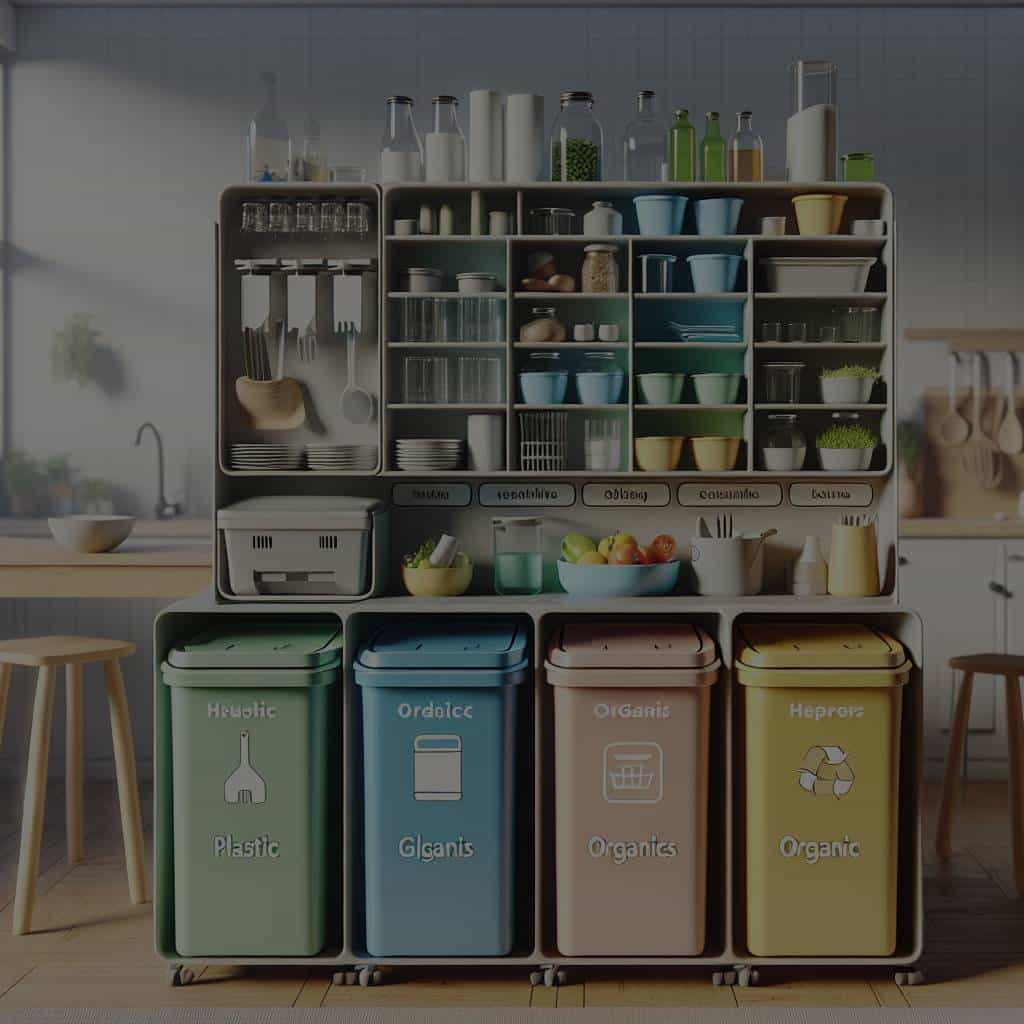As the volume of waste we produce continues to increase, implementing effective waste management systems at home has never been more critical. The environmental implications of improper waste disposal are well documented, but it’s also essential to consider the impact on our health and our communities. An effective waste sorting station at home can significantly reduce the amount of waste that ends up in landfills while also ensuring a hygienic and healthy living environment.
Understanding Waste Management and Recycling
Before diving into the design of a waste sorting station, it’s crucial to understand the importance of waste management and recycling. It’s not just about disposing of your garbage, but also about managing the resources we consume and their impact on our planet.
Also to read : What’s the Most Effective Way to Organize a Home Workshop for Electronics Projects?
Waste management involves the collection, transportation, disposal, and recycling of wastes. It aims to reduce the harmful impacts of waste on health, the environment, and aesthetics. On the other hand, recycling is the process of converting waste materials into new products to prevent waste of potentially useful materials, reduce the consumption of fresh raw materials, and lower greenhouse gas emissions.
Understanding how these processes work and why they are essential is the first step towards designing an effective waste sorting station at home. By having a clear picture of the different types of waste and how they interact with the environment, you will be able to sort your waste more effectively.
Also read : How to Create a High-Tech Home Observatory for Amateur Astronomers?
Identifying Different Types of Waste
Waste comes in many shapes and forms. Identifying the different types of waste is crucial for an effective waste sorting station at home. These include but are not limited to paper, plastic, organic waste (like food scraps), glass, metal, and hazardous waste (like batteries and paint).
Paper waste includes items like newspapers, magazines, envelopes, cardboard boxes, etc. These materials are often easily recyclable, but it’s important to remove any plastic or metal elements before recycling.
Plastic waste is perhaps the most problematic type of waste due to its non-biodegradable nature. This includes items like plastic bags, bottles, straws, and packaging materials. While many plastics can be recycled, some cannot, so it’s crucial to understand the different types of plastic and how to dispose of them properly.
Organic waste like food scraps and yard waste can be composted at home, providing a valuable resource for your garden. Glass, metal, and hazardous waste should be handled with care and disposed of correctly.
Designing Your Home Waste Sorting Station
Now that you understand the different types of waste and their impacts, it’s time to turn your focus on designing your home waste sorting station. The design of a home waste sorting station should be compact, hygienic, and user-friendly. Let’s explore the essential components of a practical home waste sorting station.
To start with, your home waste sorting station should have separate bins for different types of waste. A minimum of three bins should be enough for most households – one for recyclables (paper, plastic, glass, and metal), one for organic waste, and one for general waste.
The bins should be clearly labeled to avoid confusion. They should also be easy to clean and maintain to ensure hygiene. Depending on the space available in your home, you might want to consider stackable bins or bins that can be tucked away in a cabinet or pantry.
Washable, sealable containers are recommended for organic waste to prevent odors and pests. For recyclables, choose a container large enough to hold a week’s worth of materials.
Educating Household Members on the Importance of Waste Sorting
While designing a compact and hygienic waste sorting station at home is essential, it’s equally important to educate all household members on the importance of waste management and recycling. Everyone should understand why it’s important to sort waste, how to do it correctly, and what happens to the waste after it leaves your home.
The key is to make the sorting process as easy as possible. Clear labels on the bins and a simple guide on what can and can’t be recycled can go a long way in helping everyone get on board.
Remember, waste management is a collective responsibility. It’s not just about doing your part at home, but also about influencing your community and contributing to the broader public health and environmental goals.
In conclusion, waste management and recycling at home are not only essential for the environment but also for our health. A compact and hygienic waste sorting station is a great step towards achieving these goals. By understanding the different types of waste, designing an effective sorting station, and educating household members, you will be making a significant contribution to your community and the planet.
Making Your Home Waste Management System Sustainable
Finally, it’s essential to consider the sustainability of your home waste management system. This includes looking at ways to reduce waste production, reuse materials, and recycle as much as possible.
Reducing waste starts with mindful consumption. Try to buy only what you need, choose products with less packaging, and opt for reusable items over single-use ones whenever possible.
Reusing materials is another great way to reduce waste. Old jars can be used for storage, broken furniture can be repaired instead of thrown away, and scraps of fabric can be turned into rags or used for crafting.
Recycling is the last step in the waste hierarchy, but it’s still crucial. Ensure that you are recycling as much as possible, and always check if an item can be recycled before throwing it in the bin.
In the end, a sustainable home waste management system relies on everyone’s responsibility and commitment. It’s not just about having the right bins or knowing where to dispose of your batteries; it’s about creating a mindset of sustainability and respect for our planet.
Tackling Different Categories of Waste: Liquid, Solid, and Hazardous
To ensure that your waste sorting station effectively handles all types of waste, it’s important to categorize your waste into solid, liquid, and hazardous types. Solid waste typically refers to everyday items that are discarded, such as paper, plastic bags, food scraps, and cans. Liquid waste includes household items like cleaning solutions, oils, and any wastewater.
Solid waste is often the most straightforward to manage. You can sort solid waste into recyclables and non-recyclables, then further categorize them based on their material: paper, glass, metal, plastic. It’s also important to separate contaminated waste that can’t be recycled, like used tissues or soiled packaging, from the clean waste stream.
Hazardous waste requires particular attention due to its potential negative impact on both health and environment. This category includes products like batteries, paint, pesticides, and electronic waste, or e-waste. These items need special disposal methods to prevent harmful substances from leaching into the environment.
For liquid wastes, such as cooking oil, it’s advisable to store them in a sealable container before disposal. Never pour them down the drain as this can lead to blockages and contaminate water systems. Check with your local health department or public waste management program for guidelines on how to dispose of liquid waste properly.
Your waste disposal station should be equipped with separate bins for each type of waste. It’s also crucial to clear each container regularly, ensuring a clean and hygienic environment.
Incorporating a Comprehensive Waste Management Plan
A comprehensive waste management plan goes beyond just sorting and disposing of waste. It includes waste reduction, reuse, and recycling initiatives, and considers the volume of waste generated and the disposal methods used.
Waste reduction is the first line of defence in waste management. It involves taking steps to prevent waste from being produced in the first place. This can be achieved by buying in bulk, reducing the use of disposable items, and avoiding products with excessive packaging.
Reuse is another key component of waste reduction. By reusing items such as containers, shopping bags, and paper, we can significantly reduce the volume of new waste generated. For example, construction and demolition waste, like wood, bricks, and metals, can often be reused in other projects instead of being sent to landfill.
As for recycling, it’s crucial to have clear and separate recycling bins for different materials. However, not all items are recyclable, so it’s important to be aware of your local recycling policies and guidelines.
Ultimately, a comprehensive waste management plan requires the active participation of all household members. It’s about fostering a culture of respect for the environment and taking responsibility for the waste we produce.
Conclusion
Designing a compact and hygienic waste sorting station at home is not only beneficial for the environment but also contributes to public health by reducing the volume of waste ending up in landfills. Through understanding different types of waste – solid, liquid, and hazardous – and incorporating a comprehensive waste management plan, households can significantly reduce their environmental footprints.
However, the success of home waste management doesn’t solely rely on the right bins or a well-designed sorting station. It requires a consistent commitment from all household members and a mindset shift towards sustainability. By adopting waste reduction, reusing items, and recycling as much as possible, we can make a significant difference in our waste generation and contribute to a healthier planet.











